The verdict: The new 2018 Alfa Romeo Stelvio luxury SUV delivers sport, utility and luxury — in descending order.
Versus the competition: The Stelvio spanks the competition with its base-engine quickness, but in most regards it merely competes with, rather than leapfrogs, established players.
Sharing its platform, wheelbase, drivetrains and much more, the Stelvio is arguably a big wagon version of the Giulia sports sedan. Unlike the sedan, which made its U.S. debut in the Quadrifoglio performance trim level, the SUV starts with the base Stelvio ($42,990; all prices include destination) and the Stelvio Ti ($44,990). Alfa says the Quad will arrive in early 2018 at a price to be determined.
All Stelvios have standard all-wheel drive, called Q4, and with the exception of its standard wheel size — 19 inches versus 18 — the Ti's $2,000 price bump makes no difference in the vehicle's performance.
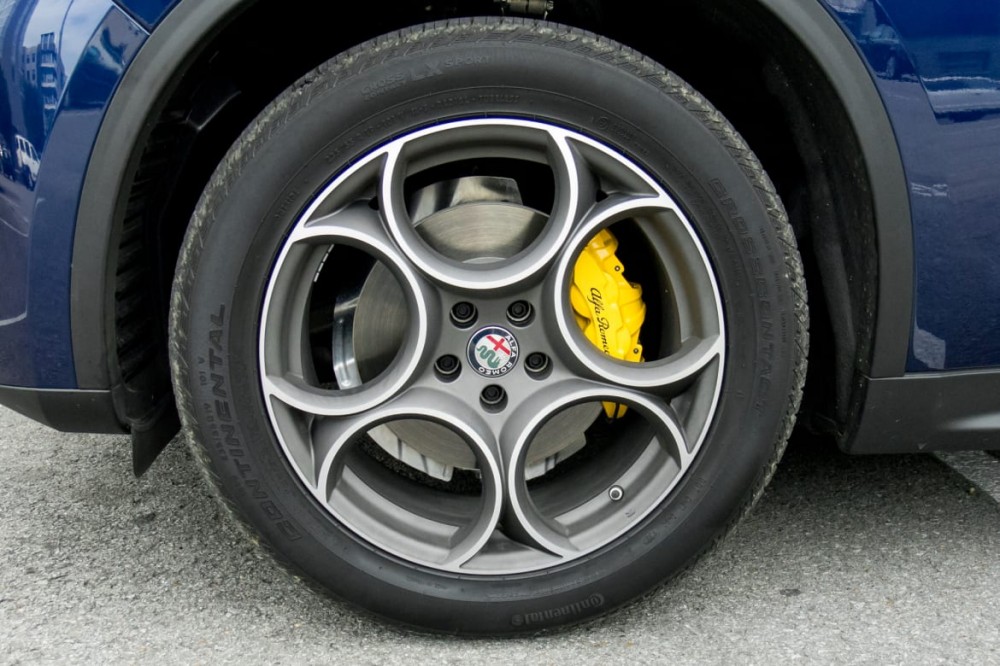
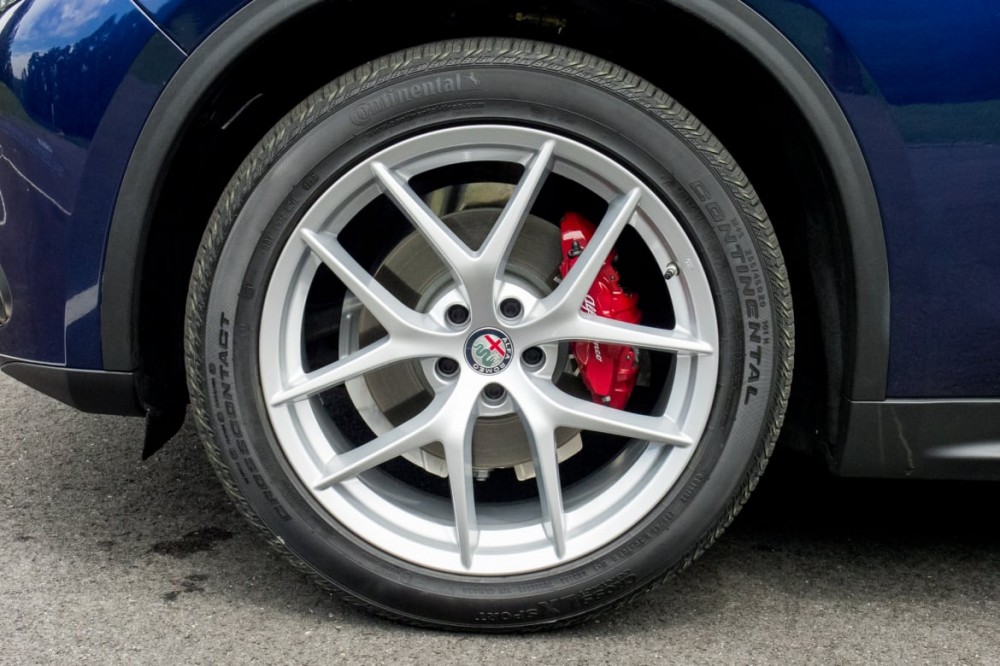
Driving upgrades come with the selection of the optional Sport Package ($1,800 on the Stelvio, $2,500 on the Stelvio Ti) or the Performance Package, which will be available later in the model year. I spent most of my time in Stelvio Ti Sport models but also put some miles on a non-Sport Stelvio to gauge its performance differences.
In price and exterior size, the Stelvio competes most closely with the BMW X3 and Jaguar F-Pace, but also with the likes of the more expensive Infiniti QX70 and Porsche Macan (compare some of these models side by side).
How It Drives
Alfa has already reported that the Quadrifoglio trim's dual-turbo 2.9-liter V-6 will propel it to 60 mph in a scant 3.9 seconds, but the base Stelvio is no slouch. Without question, a 2.0-liter four-cylinder seems wee for an SUV, even if it's turbocharged, but it's becoming more common. What's less common is what this 280-horsepower engine delivers: zero-to-60 mph in a claimed 5.4 seconds, which makes it quicker than base competitors.
As in the Giulia, this engine's torque peak is specified as 306 pounds-feet at 2,000 rpm, but it feels like it needs to wind out a bit more than that to really get moving. You won't mistake this for a bigger block, but the Stelvio makes it work thanks to one of the Giulia's high points: a responsive eight-speed automatic transmission. It upshifts smartly and downshifts readily, and with the rotary drive mode knob set to Dynamic mode, it both predictably holds on to lower gears to higher rpm and responds to a jab of the accelerator when you need kickdown.
It's in manual mode, however, where you see how quickly the transmission reacts. Even the base Stelvio performs in this regard, but there's little joy without the shift paddles that come with the Sport Package: giant aluminum paddles that are mounted to the steering column rather than the wheel. They're just as satisfying here as they are on the Giulia. It might take a day or two to acclimate to reaching for the turn-signal or wiper stalks behind the paddles, but it's worth it.
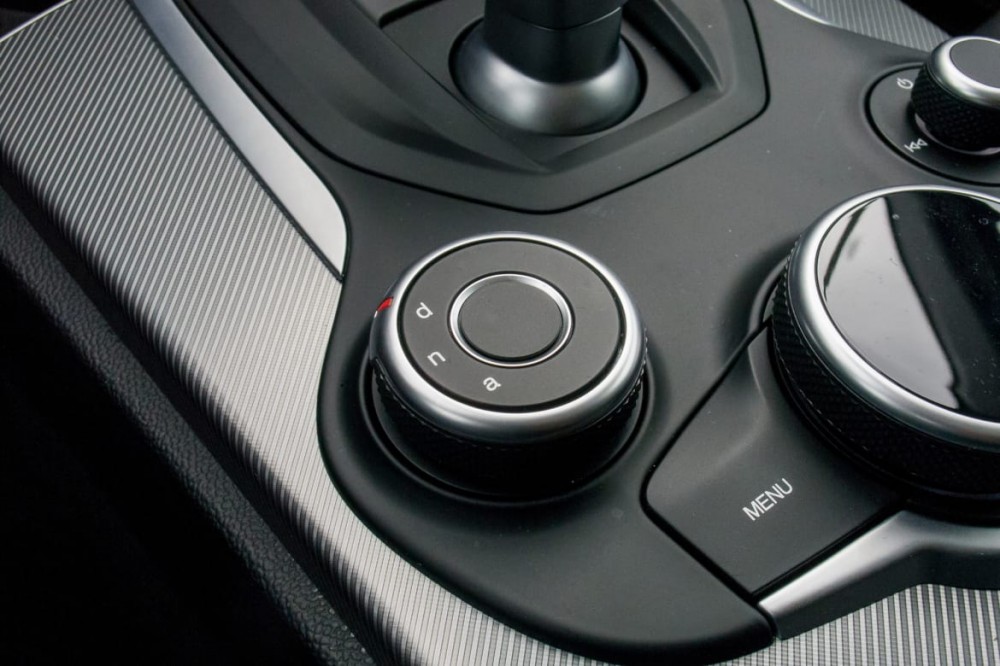
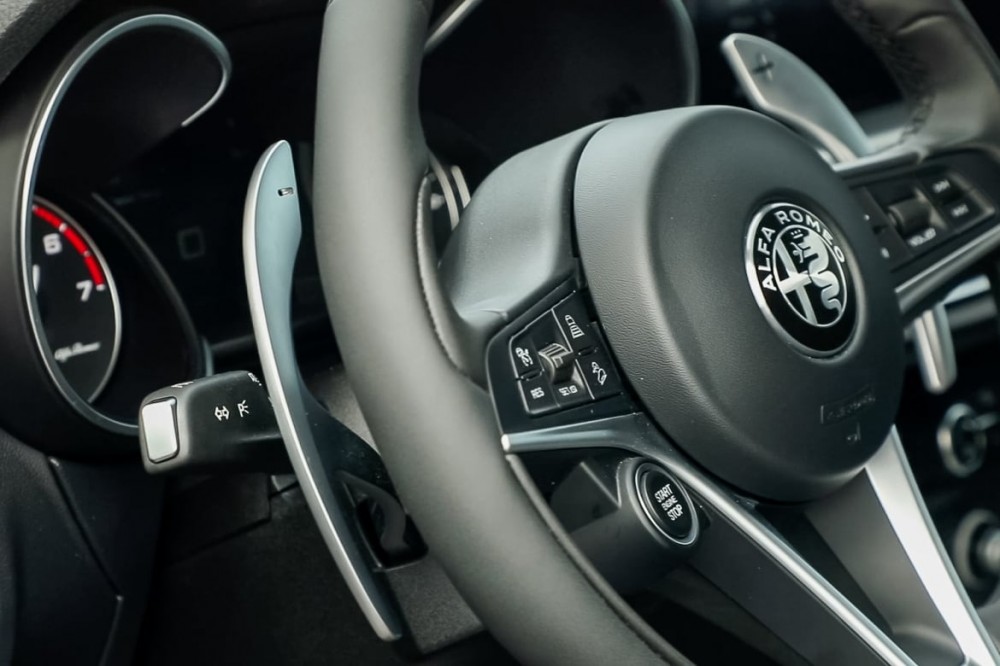
This isn't the only responsive automatic transmission on the market, but typically this kind of performance comes from dual-clutch automated manuals like Porsche's PDK or Audi's S tronic. What amazes us is that this is the same conventional eight-speed automatic from Germany's ZF that many other vehicles use — sometimes dismally. Set the DNA knob to N, for Natural mode, and it's not as quick to kick down, but it still behaves better than do most transmissions of its ilk. There's also an "A" on that knob; it stands for Advanced Efficiency.
The base Stelvio's EPA-estimated gas mileage is 22/28/24 mpg city/highway/combined; that combined number is right in line with the best gas-powered figures of the X3 and F-Pace. (A diesel F-Pace 20d achieves an estimated 29 mpg combined in exchange for lesser acceleration.) The Macan's best rating is 22 mpg combined.
The Stelvio Ti Sport handles nicely. Alfa cites a weight distribution of 50/50 front/rear, but I felt a good deal of understeer nosing into corners. Applying some gas brings the tail around and balances things out nicely, but you need to be mindful of your gear, either manually or by choosing Dynamic mode. If you're in Natural or Advanced Efficiency mode, even this transmission won't be quick enough to get the small engine into its torque band and power you out of the turn. According to Alfa, the Q4 AWD sends all the torque to the rear wheels as a default, but up to 60 percent can go to the front when needed. In the future, a mechanical limited-slip rear differential will become available as an option; sadly, I didn't have access to a racetrack, but on the street the system performed fine as-is.
Likewise, Alfa promises an adaptive suspension option for the Stelvio, as well as standard on the Quadrifoglio version, which will provide computer-controlled variable shock-absorber rates, along with a push-button control at the center of the mode-selector knob. Until then, your choice is between regular and sport tuning.
Despite having upgraded 20-inch wheels, the Sport I drove was comfortable on the well-maintained roads around Nashville, Tenn. — firm, yes, but by no means hard or punishing. Back in pavement-challenged Chicago, however, a similarly equipped Ti Sport was too firm for some of our tastes, including some young backseat passengers who've never voiced such a complaint in the past. The regular Stelvio had noticeably more body roll than the Ti Sport even with optional 19s rather than 18-inch wheels, so I strongly recommend the Sport Package unless your roads are bad news or you're particularly sensitive. Or you can wait for the adaptive setup.
Though it shares the sedan's wheelbase and steering ratio, the Stelvio's steering didn't feel as quick to me as the AWD Giulia Ti we recently tested, but neither did it feel as overboosted. Perhaps it all just jelled with the SUV's characteristics — when equipped with the Sport Package.
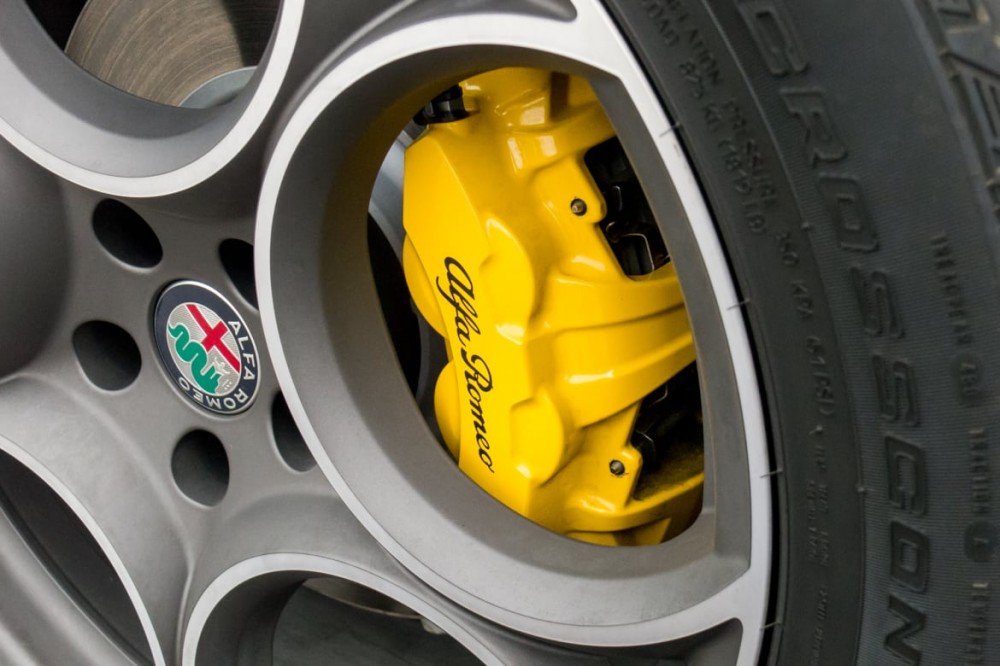
Ironically, the one thing that somewhat put the brakes on my enthusiasm was the Stelvio's brakes. In a couple of staged panic stops, the standard Brembo brakes with four-piston front and single-piston rear calipers provided decent stopping power, but pedal feel overall was quite numb and the action nonlinear. This is a complaint I've also had, even stronger, about the 4C. What appear to be the same brakes as the Stelvio performed a bit better on the Giulia, with stronger stopping power (understandable, given the weight difference) and better linearity and feel, though still not the best.
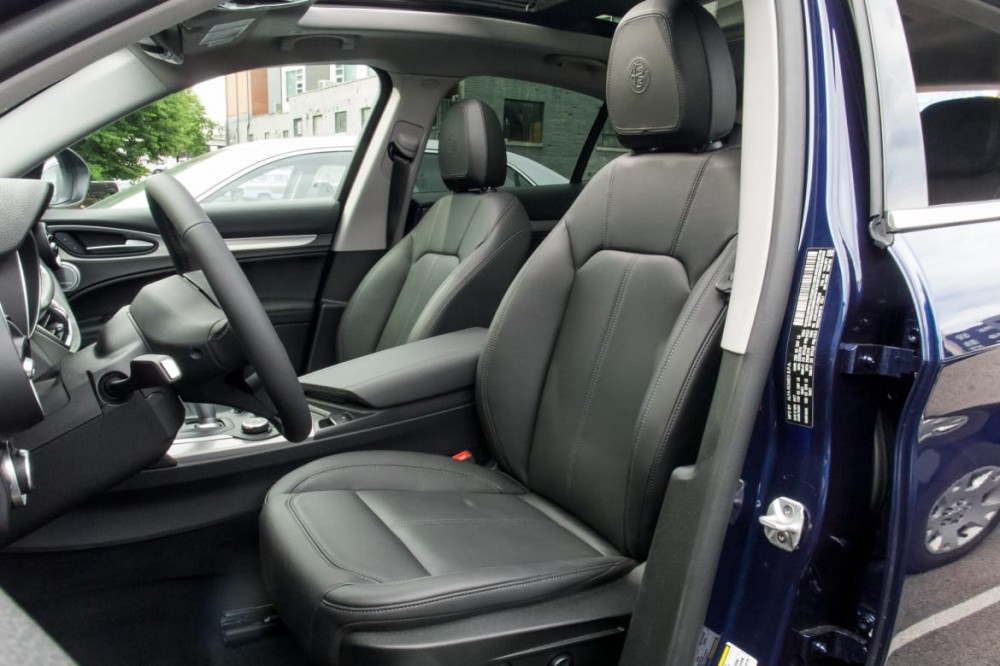
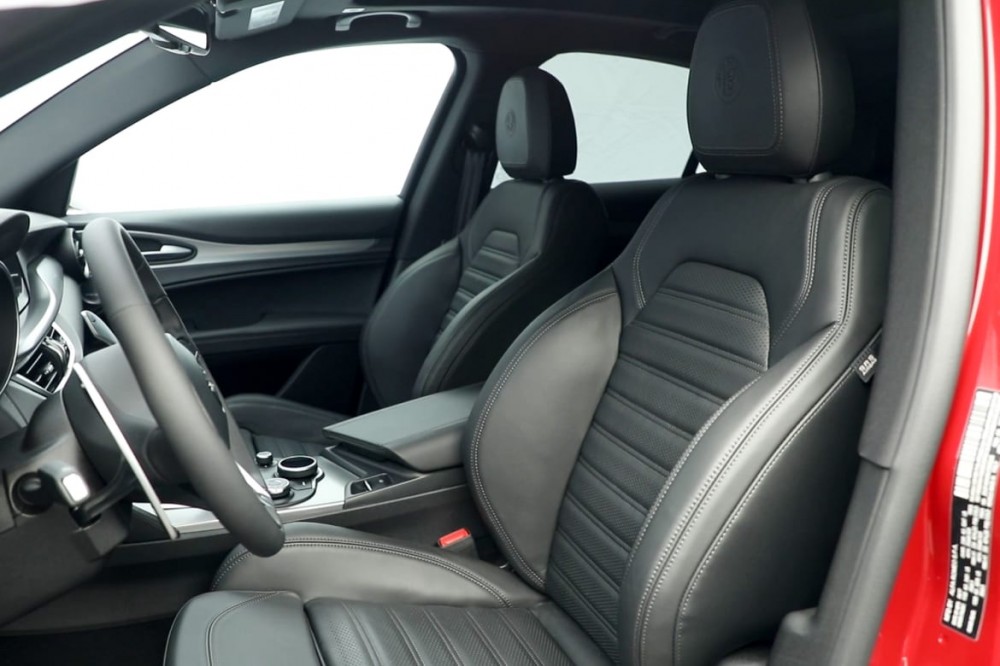
In the Cabin
The Stelvio's cabin has its pros and cons. A major pro is the front seats. They're standard leather, where the X3 and F-Pace have leatherette (imitation leather), and they're borderline sport seats — more prominent side bolsters on the backrests than a typical SUV, but nothing crazy — and the head restraint is adjustable. Even better, the sport leather seats that come with the Ti Sport Package have more aggressive bolsters high and low, yet the backrest versions are power-adjustable and more accommodating of larger occupants than are many sport seats. The head restraints remain adjustable, and there's a manual thigh-support adjustment.
Once seated, you'll find outward visibility isn't great due to relatively thick A-pillars and smallish windows, especially toward the rear. This is the norm for sportier SUV designs, but it's exacerbated here by large backseat head restraints that don't nest down into their seatbacks as some newer designs do.
Overall, interior quality is decent for the Stelvio's starting price, but the options don't seem to take it much further. An optional red interior seems like the right idea, but there's little else to express the Italian emotion we know is there. There are some plain plastics on the doors and console, and we had some tactile complaints, as well. Alfa Romeo improved upon the feel and sound of the rotary multimedia controller and DNA knob, which came across as rickety and cheap in the sedan, but they're still not as precise and rich as they need to feel.
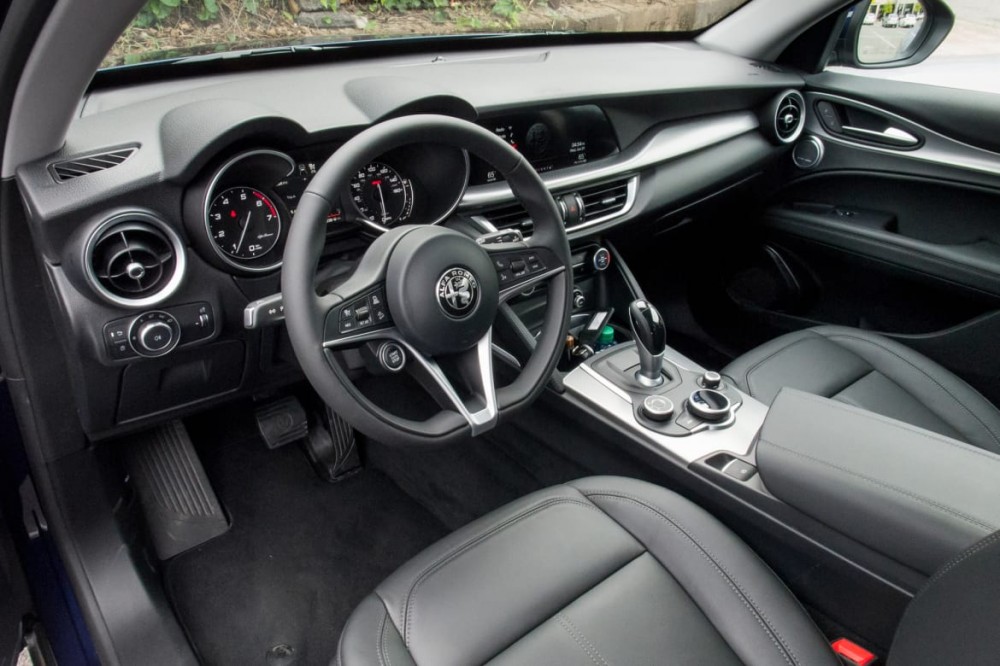
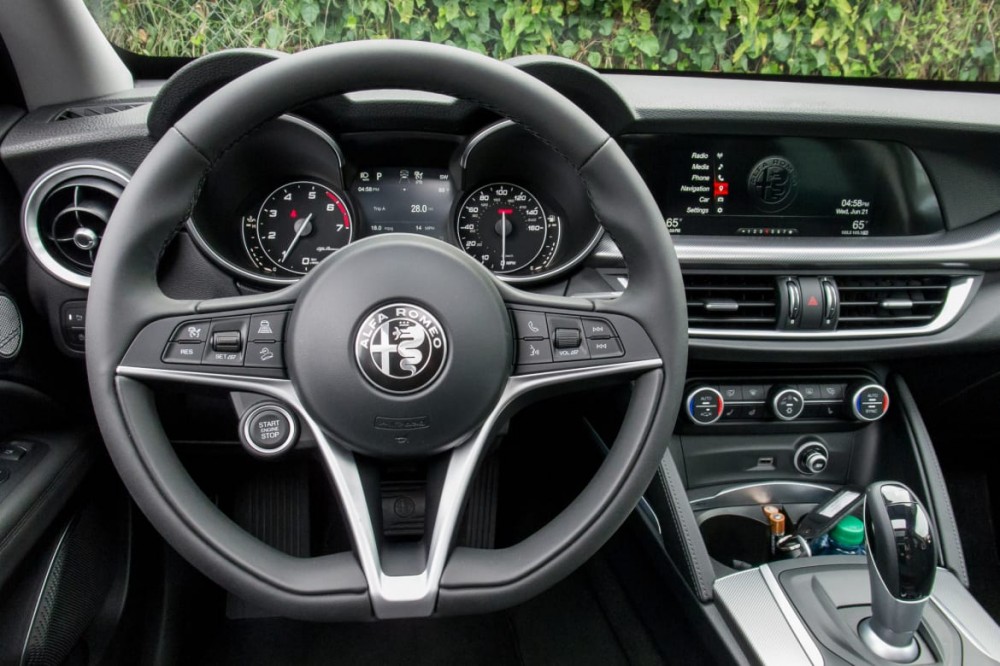
I don't care for the way the turn-signal stalk springs back to center rather than staying put until the turn is complete. (Ford and BMW, who began this trend, are getting away from it and Alfa should, too.) Even worse, if you hold the stalk in position, it still blinks the signals only a few times and then stops. If this complaint seems petty to you, take it from someone who fields complaints from countless longtime owners: The lasting annoyances are the ones that matter, and this stalk seems like a prime one.
Sport, But Utility?
It's not uncommon for sportier sport utilities to underperform in the utility regard, and that does describe the Stelvio to an extent. Its shape makes for less headroom and overall interior volume than you'd find in a boxier SUV, but the numbers suggest it compares to direct competitors in headroom: Its 40.2 inches of front headroom is just a half-inch less than the X3, about an inch better than the QX70 and 2.4 inches better than the F-Pace. Its 38.9 inches of backseat headroom is two-tenths shy of the X3 but almost a half-inch more than the QX70 and more than an inch and a half roomier than the F-Pace.
In front-seat legroom, however, the specifications suggest the Stelvio is way behind — 36.6 inches versus 39.9 in the X3, 44.7 in the Infiniti and 40.3 in the Jaguar. I have to say, though, I have long legs and I was comfortable. Alfa gives a backseat legroom specification of 35.9 inches, which seems accurate versus the X3 (36.5), QX70 (34.6) and F-Pace (37.2). The seat is by no means cavernous, but at 6 feet tall, I was able to sit behind the driver's seat positioned for myself and I was fine. The optional dual-pane sunroof gives the backseat an airier feel.
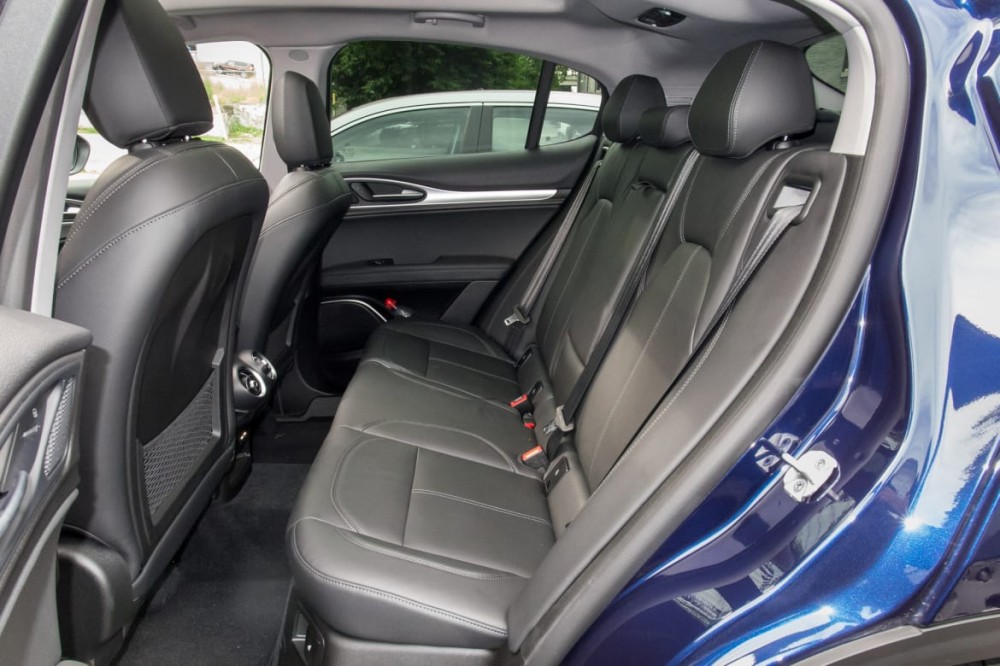
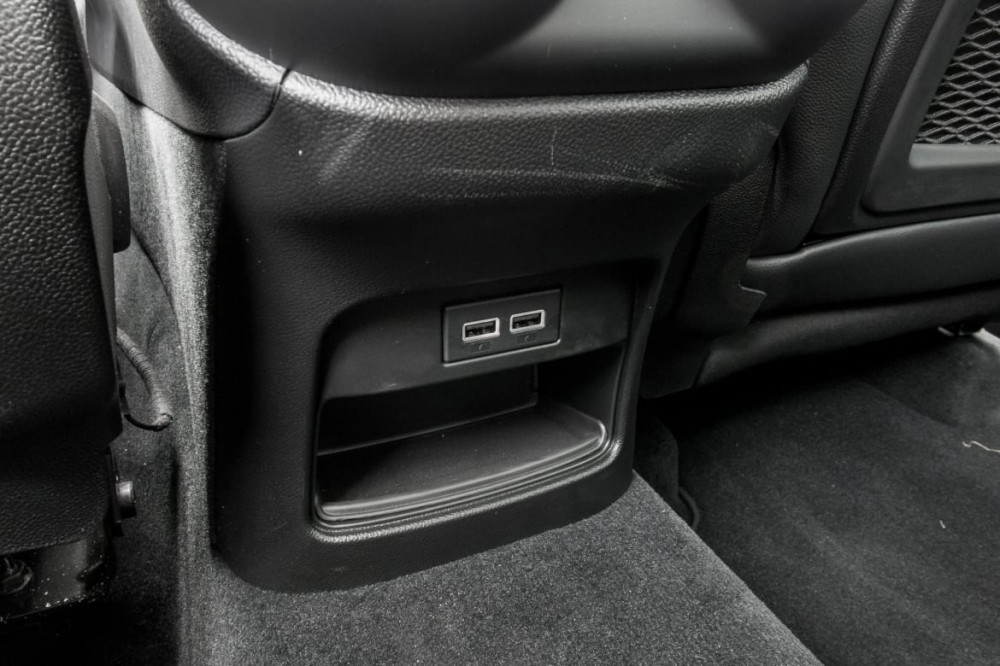
The backseat wasn't super accommodating for child-safety seats, however, as detailed in our Car Seat Check. The infant seat and rear-facing convertible seat had to steal legroom from the front occupant.
The cabin is also lean on storage compartments, so family duty isn't this model's strength in most respects.
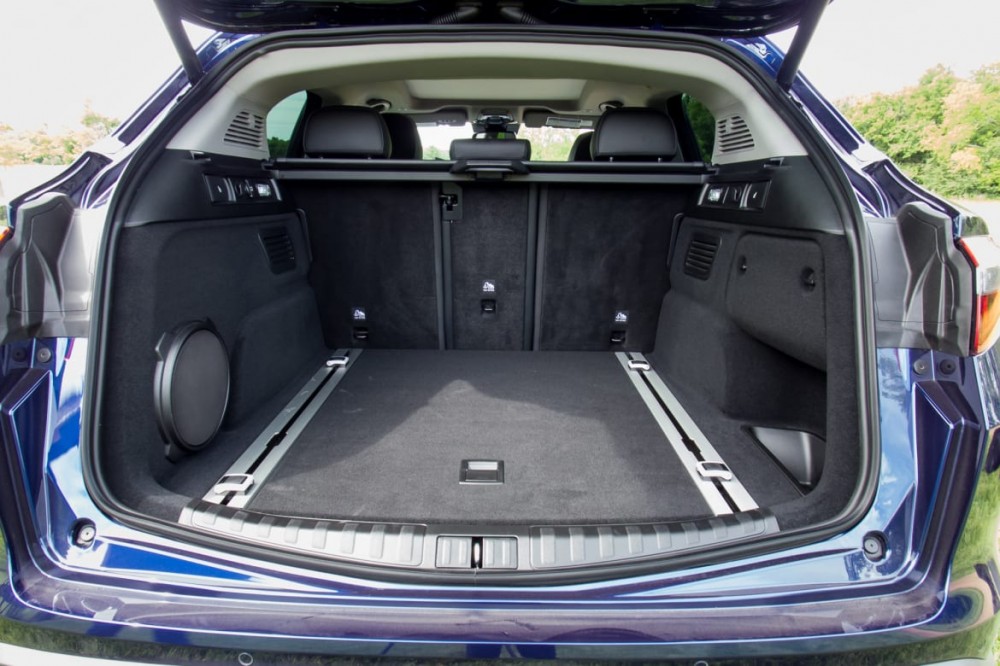
The Stelvio's cargo volume, specified as 18.5 cubic feet behind the backseat, once again seems too low — trailing the X3 (27.6), QX70 (24.8) and F-Pace (33.5) but beating the Porsche Macan's 17.7 cubic feet. We've found cargo specs in particular to be unreliable, so you'll have to check out the vehicles yourself to be sure. In practice, we found the Stelvio's cargo area to be wide open and usable, though the sloping profile certainly compromises its height to the rear. We appreciated the 40/20/40-split folding backseat with release levers accessible from the rear bumper, as well as the adjustable tie-down hooks included with an optional Convenience Package.
Ergonomics & Electronics
All the Stelvios we evaluated had an optional 8.8-inch display rather than the 6.5-inch version that's standard in the base Stelvio. The bigger screen was a bit disappointing in some ways — made worse by the fact that most vehicles from Fiat Chrysler Automobiles, Alfa's parent company, offer the well-regarded Uconnect touchscreen system. The Stelvio instead has a wide, short display that's not a touchscreen, paired with a console-mounted, multifunction knob flanked by two buttons. Wide screens are great for epic video, but in a car, a display needs height as well. Everyone who drove the Stelvio noted how tiny the backup camera image was given the width of the display.
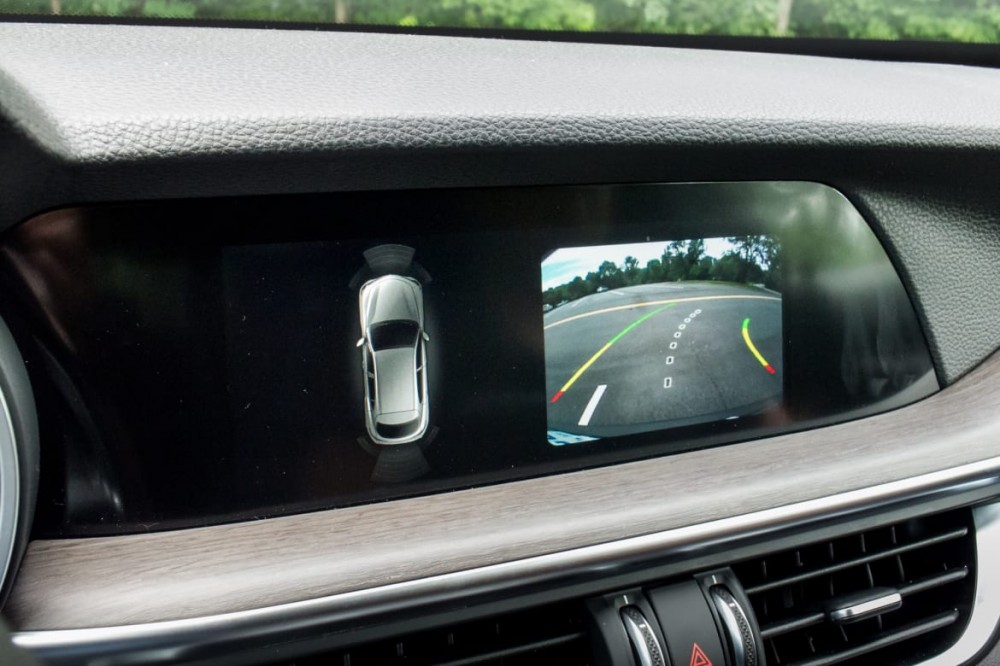
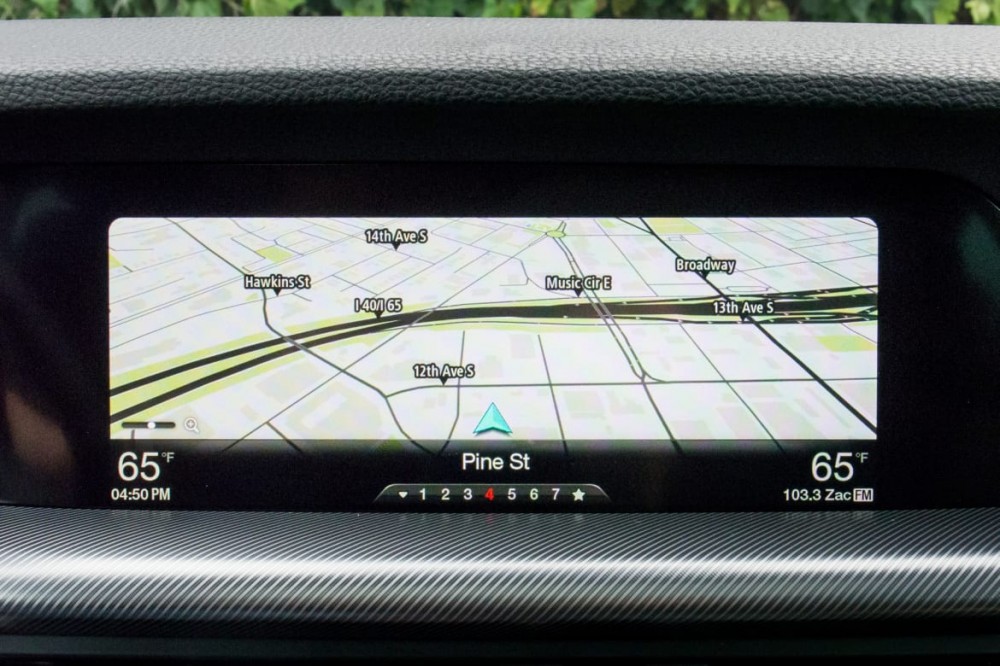
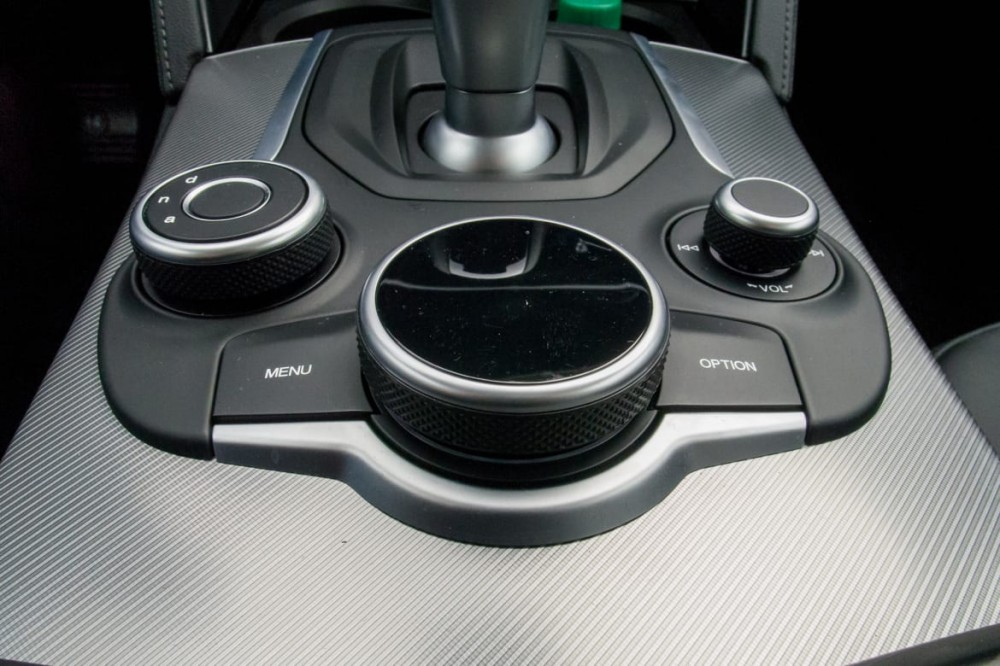
At a glance, the system seems refreshingly simple in its menu structure and usability. Over time, though, our editors complained of overcomplicated tasks, like inputting navigation destinations and zooming in on the map.
Apple CarPlay and Android Auto will arrive later in the model year, and both will be standard. There are two USB ports in front and two more for charging mobile devices in the backseat.
Safety
As of publication, the Stelvio hadn't been crash-tested by the National Highway Traffic Safety Administration or the Insurance Institute for Highway Safety.
Standard features include a backup camera and rear parking sensors. Front sensors are standard on the Stelvio Ti and can be added to the base model in an optional Driver Assistance Static Package, which also includes auto-dimming mirrors and a blind spot warning system with rear cross-path detection. The Driver Assistance Dynamic Plus Package, which requires the Static package, adds forward collision warning with automatic emergency braking, lane departure warning, automatic high beams and adaptive cruise control that works all the way to a stop. Not available are lane departure prevention and lane-centering.
Editor's note: This review was updated Sept. 12, 2017, to reflect that Apple CarPlay and Android Auto will become standard later in model-year 2018.








